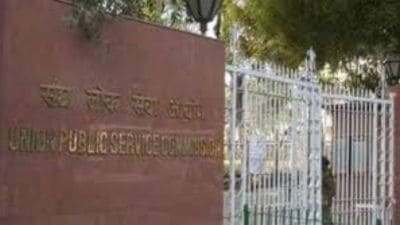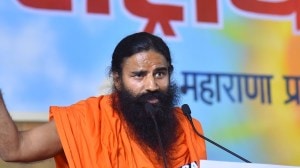- India
- International
Here is how Modi govt performed in one year; you can rate the ministries
A series on the key events in various ministries during the first year of the Narendra Modi government.
 September 28, 2014. Narendra Modi at Madison Square Garden during his visit to the United States.
September 28, 2014. Narendra Modi at Madison Square Garden during his visit to the United States.
By: Ruhi Tewari, Abantika Ghosh, Raghvendra Rao, Manoj CG, Maneesh Chhibber, Shubhajit Roy, Pradeep Kaushal, Pranav Kulkarni, Avishek G Dastidar and Vijaita Singh
The Indian Express has started a series on the key events in various ministries during the first year of the Narendra Modi government, what they promised and what they delivered, how they rate their performances — and what their rivals think.
READ: One year of Narendra Modi government: What they promised and what they delivered
READ: A look at what these five ministries promised and what they delivered
READ: One year of Narendra Modi-led government: Ministry Meter
Rural Development- Stalled land acquisition law, NREGA worries
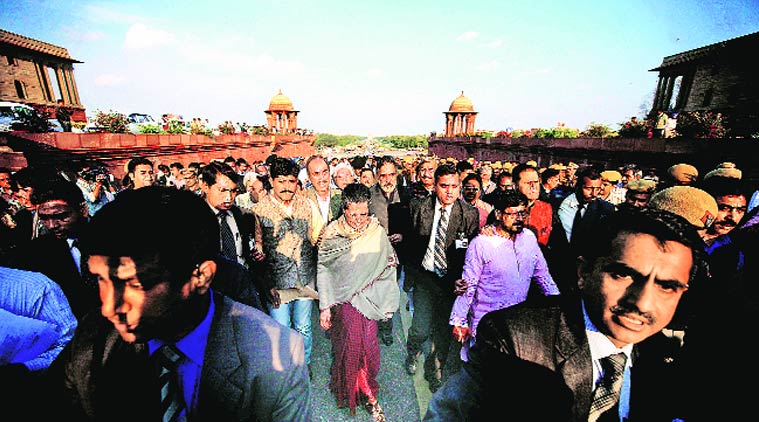 March 2015. Sonia leads march to Parliament against land bill. (Express Photo by: Praveen Khanna)
March 2015. Sonia leads march to Parliament against land bill. (Express Photo by: Praveen Khanna)
PROMISES

The Prime Minister’s Sansad Adarsh Gram Yojana; convergence of activities under MGNREGA including with Swachh Bharat Abhiyan. The ministry also announced a new land acquisition law to replace the 2013 legislation.
PLUSES
The ministry has brought in some new initiatives under MGNREGA to check delayed payments, such as a mobile monitoring system, and to ensure better quality of assets created by setting “outcome oriented” targets.
MINUSES
The ministry has been unable to get its Land Acquisition (Amendment) Bill passed by Parliament, constricted by its numbers in the Rajya Sabha. The year also saw the worst performance of MGNREGA since its introduction in terms of time when wages are paid and number of days of work provided to each household, with a funds crunch and erratic disbursement proving a constraint.
SELF-RATING
“The main achievement has been to successfully focus and converge all programmes of the ministries of Rural Development, Panchayati Raj, Drinking Water & Sanitation to the real issues at ground level. From the extremely successful Pradhan Mantri Gram Sadak Yojana to the highly popular Swacch Bharat Abhiyan, the focus of all schemes is on how to make a real difference for the rural population. We are excited about the… change we can usher in under the able leadership of our PM.” –Birender Kumar Rural development Minister
OPPOSITION RATING
“The main highlight of the ministry in the last one year is the systematic attempts to dismantle the 2013 land acquisition law. That is there in front of the entire country. The allocations for the ministry for key flagship programmes have been slashed very, very drastically. The National Rural Livelihood Mission (allocations) have been slashed from Rs 4,000 crore to Rs 2,500 crore. Even for a programme like the Pradhan Mantri Gram Sadak Yojana, the allocations have been cut down to Rs 14,000 crore from Rs 20,000 crore and there is huge uncertainty on MGNREGA. So the Rural Development Ministry, which was a locomotive during the UPA regime, has lost its steam in the last one year.”- N Jairam Ramesh Member, Congress shadow group on rural development
Human Resource Development- New education policy, FYUP and Sanskrit rows
 Teachers’ Day. Madrasa students in Mumbai watch Modi speak.(Express Photo by: Prashant Nadkar)
Teachers’ Day. Madrasa students in Mumbai watch Modi speak.(Express Photo by: Prashant Nadkar)
PROMISES
The HRD Ministry promised to bring in a new National Education Policy. It also announced a new Choice Bases Credit Framework for colleges and set up committees to review regulators such as UGC and AICTE.
PLUSES
The ministry began consultations on the new National Education Policy, deciding to adopt a bottom-up approach. Teacher Education Reforms were also initiated and several scholarship schemes such as Ishan Vikas, Ishan Uday and Pragati were brought in.
MINUSES
The ministry has run into a number of controversies — the rollback of the Four Year Undergraduate Programme in Delhi University; the replacement of German with Sanskrit as third language in Kendriya Vidyalayas; the celebration of Good Governance Day on Christmas,the IIT-UGC standoff over degrees; the resignation of some key people such as NCERT director Parvin Sinclair, IIT Delhi director R Shevgaonkar and IIT Bombay board of governors chairman Anil Kakodkar (who later withdrew the resignation). Several key positions remain vacant.
SELF-RATING
“We have undertaken a collaborative and holistic approach that ensures improvement in the quality of education, leverages technology, engages with community, is inclusive in implementation, and will facilitate social development. We have worked hard to implement initiatives that are inclusive, ensuring that all students participate in mainstream education, be it initiatives to encourage girls to enrol in technical education, exposing students from the Northeast to premier institutes, training our educators to teach specially abled students, or streamlining vocation education… We have broken the silos between our institutions and departments of higher and school education… We have launched the new Education Policy consultations as a democratic process in which in every region and state will elicit the views of the people regarding the National Education Policy. For the first time, 2.75 lakh village education councils, blocks, districts and states will participate in the consultative process. The ministry wants teachers, students, parents, community members, private sector and government to work together and engage in the process of developing our education policy for the next generation. Change is no longer the preserve of only a few experts.”
* Smriti Irani, HRD Minister
OPPOSITION RATING
“Our biggest apprehension was saffronisation of education. But minister Irani seems to be aware that we are keeping this aspect of her policy-making under close scrutiny with the result that our vigilance has been able to rein in somewhat such saffronisation. However, particularly in the ICHR, we have deep concerns. As regards appointments to institutions of higher education, scores of vice chancellor posts are vacant and many teaching positions have not been filled. In Sarva Shiksha Abhiyan there are apprehensions over the consequences of the huge reduction in the SSA budget especially as it is highly under doubt that the additional untied funds being given to the states under the 14th Finance Commission will effectively be earmarked for the elementary education sector.”
* Mani Shankar Aiyar Head, Congress shadow group on HRD
Info and broadcasting- Standoff with censors, promises to keep
 October 2014. A farmer in Sangli listens to Modi on radio.(Express Photo by: Prashant Nadkar) October 2014. A farmer in Sangli listens to Modi on radio.(Express Photo by: Prashant Nadkar)
October 2014. A farmer in Sangli listens to Modi on radio.(Express Photo by: Prashant Nadkar) October 2014. A farmer in Sangli listens to Modi on radio.(Express Photo by: Prashant Nadkar)
PROMISES
It announced plans to start new channels Kisan TV and Arun Prabha and to accord the status of institutes of national importance to FTII Pune and SRFTI Kolkata and the setting up of a National Centre of Excellence in animation and special effects. None of this has happened yet.
PLUSES
The government is now working overtime to launch DD Kisan on May 26, the date it had been sworn in.
MINUSES
A number of controversies during the year included telecasting live RSS Chief Mohan Bhagwat’s annual Vijaya Dashami speech, a casual newsreader describing Chinese President Xi as “Eleven”, and a row with the Central Board of Film Certification leading to chairperson Leela Samson’s resignation citing interference and corruption of panel members and officials appointed by the ministry. Key appointments in CBFC and Prasar Bharati Board have not yet been made.
SELF-RATING
“The Kisan Channel is being launched, DD India is being launched. We are launching Vividh Bharati on FM. As far as the delay is concerned, the important thing is that when you do something, you do it well. How we’ve been able to take Mann Ki Baat on different platforms – now you can see it also and you can hear it also… and it’s online, it’s on TV… In a major way, we’ve gone online. DD is on a mobile application now. Websites are being updated. All the information of the government… we’ve been able to disseminate it in a very organised manner. As far as filling up vacancies is concerned, does this board belong to a political party or a government? I believe it belongs to the government. And therefore, we have the faith that these people will continue doing a neutral job, and they are doing a neutral job.- Rajyavardhan Rathore MoS, I&B
OPPOSITION RATING
“Nothing to write home about. The highlight is Talibanisation of the censor board. The government tried to block information to the media. There have been attacks on the profession of journalism. Attempts have been made to curtail their freedom. The film industry is upset. We have seen the protest by censor board members. I can say that attempts are on to saffronise and communalise the board as well.- M Veerappa Moily head, Congress shadow group on I&B
Women & child development- Beti Bachao and relook at juvenile age
 Maneka Gandhi launches WCD ministry’s new logo. (Express Photo by: Renuka Puri) Maneka Gandhi launches WCD ministry’s new logo. (Express Photo by: Renuka Puri)
Maneka Gandhi launches WCD ministry’s new logo. (Express Photo by: Renuka Puri) Maneka Gandhi launches WCD ministry’s new logo. (Express Photo by: Renuka Puri)
PROMISES
The ministry’s defining feature has been the Beti Bachao Beti Padhao scheme — a Rs 100 crore initiative across 100 districts that seeks to better sex ratios through a host of initiatives. The scheme was launched with fanfare in January this year with Prime Minister Narendra Modi making a plea to a packed audience in Panipat to save the girl child. Haryana has some of the districts with the worst sex ratios in the country.
The ministry has also been in the news for the Juvenile Justice (Care and Protection of Children) Bill, 2015 that has a provision that allows juvenile accused aged between 16-18 who are accused of heinous crimes, such as rape or murder, to be tried under the Indian Penal Code — laws under which adult offenders are tried. The bill has done several rounds among Parliament, standing committees, the ministry and the cabinet but is yet to be passed because of repeated adjournments in the Rajya Sabha.
PLUSES
The Beti Bachao scheme has progressed well, according to reports for the first four months from the selected districts. The first rape crisis centre will open in Chhattisgarh next month.
MINUSES
The ministry has faced large cuts in funds for the social sector, in particular the child nutrition scheme ICDS slashed. The total budget has been halved.
SELF-RATING
“In all the districts where it (Beti Bachao scheme) was launched we have managed to ensure 100% institutional delivery, there have been many foiled child marriages and the number of girls in orphanages has gone up. The latter means at least the girls are being born. The reports from the DMs have been very positive. We will do a sex ratio assessment next February in these districts to see where we stand. By the end of the next year we will get one rape crisis centre in each district up and going. The NCW Act is still to be passed. I was very keen on reforming the Rashtriya Mahila Kosh; that is still work half done. Beti Bachao Beti Padhao and the National Nutrition Mission are also among my priorities for the next year.”-Maneka Gandhi, WCD Minister
OPPOSITION RATING
“There are big budgetary cuts. Funds for Integrated Child Development Scheme have been halved. There are cuts in national nutrition mission. The performance of the ministry has been dismal. There are no new initiatives and no money.” Ghulam Nabi Azad head, Congress shadow group on WCD
Minister change, immunisation, tobacco debate
March 2015. J P Nadda at launch of Mission Indradhanush.(Express Photo by: Prem Nath Pandey) March 2015. J P Nadda at launch of Mission Indradhanush.(Express Photo by: Prem Nath Pandey)
Health- Minister change, immunisation, tobacco debate
 March 2015. J P Nadda at launch of Mission Indradhanush.(Express Photo by: Prem Nath Pandey)
March 2015. J P Nadda at launch of Mission Indradhanush.(Express Photo by: Prem Nath Pandey)
PROMISES
For the first six months, the ministry saw a flurry of activity and announcements about health assurance and tobacco. Following the sudden replacement of Harshvardhan with J P Nadda as Health Minister, all the focus is now on Mission Indradhanush to increase immunisation coverage utilising lessons learnt from the very successful pulse polio programme. National Health Assurance Mission, among the first announcements of the new government, remains a promise. The free drugs and diagnostics schemes promised too is yet to see the light of day.
PLUSES
India Newborn Action Plan was launched in September 2014. A national deworming programme too launched. A decision has been taken to introduce new vaccines in the universal immunisation programme, including rotavirus that kills many babies. A survey has been commissioned on drug-resistant TB. A National Health Portal has been launched. The government now has a National Mental Health Policy too. For the next year, noncommunicable diseases including cancer are a big focus area. Japanese encephalitis, acute encephalitis syndrome , kala azar and arsenic contamination have been identified as “low hanging” fruit.
MINUSES
The biggest controversy has been the decision to stall the larger health warnings based on the recommendation of a parliamentary committee — which included Allahabad MP S C Gupta who owns a beedi empire worth Rs 250 crore. Gupta and the committee chairman, Dilip Gandhi, questioned the available evidence on health effects of tobacco and demanded Indian studies be done first. The ministry has acceded to the committee’s suggestion that larger warnings be put on hold even though the recommendation was not binding on it. During Harshvardhan’s stint, he faced criticism for stripping Indian Forest Service officer Sanjeev Chaturvedi of the charge of vigilance office of AIIMS.
SELF-RATING
“We are committed to providing affordable, accessible healthcare for all. Our focus is on reducing out-of-pocket expenses and improving health indicators substantially.” – J P Nadda, Health Minister
OPPOSITION RATING
“I don’t know whether a ministry like health exists, because there is no progress. The ministers are good but ministers in this government are totally powerless. The secretaries are directly dealing with the PMO. I don’t know who is dealing with health in the PMO. Whosoever is, does he or she know anything about health? Budgetary allocations have been slashed for NRHM, NACO, Ayush and many other areas.- Ghulam Nabi Azad head, Cong shadow group on health
Water Resources: Ganga comes first but work crawls, rivers move to link
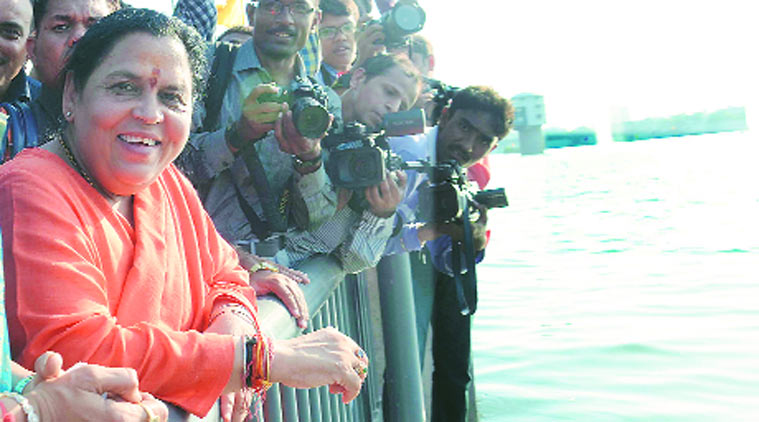 Uma Bharti on the Sabarmati in Gujarat. (Source: Express photo by Javed Raja)
Uma Bharti on the Sabarmati in Gujarat. (Source: Express photo by Javed Raja)
Promises
Cleaning of the Ganga became the primary task of the Water Resources Ministry in the last one year. The government promised it would not just rid the river of pollution but also ensure that it has adequate flow throughout the stretch and regenerate biodiversity in the river. The other high-profile promise was to begin work on interlinking of rivers.
Pluses
Last week, the government approved a Rs 20,000 crore budget for the Ganga cleaning exercise for the next five years. On the river interlinking project, work has been going on for over three decades now; the current government has managed to accelerate the work in its first year. The first project, the Ken-Betwa link, has already been cleared by the cabinet. Six more are likely to be approved soon. A programme for aquifer mapping has started. A comprehensive water information system has been put online.
Minuses
The Ganga cleaning has progressed at a slow pace. The ministry has lacked clarity on what exactly has to be done. The work required involvement of a number of agencies and departments and that has hampered the pace. Following the clearance of Rs 20,000 crore,officials say work is likely to gather pace in a couple of months. With the Ganga project and the interlinking of rivers taking up most of the attention of the ministry, many other programmes have suffered. Little progress has been made on installing an early warning system for floods. The Water Mission under the National Action Plan on Climate Change has got little attention.
Self-rating
“I am 100 per cent satisfied with the work my ministry was able to do in its first year. I had set out three objectives and I am very happy that my ministry has been deliver on all of these. The first of course was Ganga cleaning. A lot of work has been done in consultation with every possible stakeholder. The government has just cleared Rs 20,000 crore for the programme. Ganga cleaning will be one of the biggest successes of this government. I am very happy with the progress on the interlinking of rivers. We have been able to do in one year what the previous government couldn’t accomplish in 10 years. The third thing I wanted to do, and which I have achieved in doing, is fast-tracking of clearance for projects under the Accelerated Irrigation Benefits Programme and the Flood Management Programme.
♦ Uma Bharti, Minister, Water Resources, River Development and Ganga Rejuvenation
Opposition rating
“The Water Resources Ministry has become all about Ganga, but even then it is only sound and fury. Very little progress seems to have been made. What is tragic is that we have not even heard about other very important things. A separate agency to encourage water conservation was under creation. We don’t know what happened to that. We have already seen very drastic cuts in the budget of the ministry. Which means very useful programmes like the AIBP and FMP will suffer. The performance has been very disappointing, and if programmes like AIBP and FMP are allowed to suffer, it will very badly impact our farmers and rural population.
♦ Pawan Kumar Bansal, Former water resources minister
Promises
Soon after taking charge, Home Minister Rajnath Singh promised a new national policy to address Left Wing Extremism, as well as long-term visas to persecuted minorities from Pakistan, Bangladesh and Afghanistan.
Pluses
Among administrative measures, enhancement of compensation to civilian victims of communal, terrorist or Naxal violence from Rs 3 lakh to Rs 5 lakh, and for 1984 anti-Sikh riot victims also to Rs 5 lakh. The ministry cleared recruitment of 33 per cent women in police forces in all UTs and Delhi; higher financial powers to DGPs of Central Armed Police Forces (CAPF) for various procurements. Merger of Persons of Indian Origin (PIO) and Overseas Citizens of India (OCI) cards simplifies system to one OCI card with enhanced benefits; electronic-tourist visas extended to 150 countries. In policing, NIA unearthed a module of Jamaat-ul-Mujahideen Bangladesh; arrested more than 60 cadres of Assam’s NDFB(S) that had killed gunned down 78 people in 2014. Incidents of LWE-related violence dipped 22 per cent from the previous year.
Minuses
The ministry has courted a number of controversies, including a ban on India’s Daughter, Leslee Udwin’s documentary on the 2012 gangrape on a bus in Delhi. A lookout circular against Greenpeace activist Priya Pillai led to the Delhi High Court pulling the government up. The government also put donations from 16 overseas NGOs including Ford Foundation subject to prior approval. A major controversy was the ministry’s removal of home secretary Anil Goswami amid allegations that he had called CBI officials to stall the arrest of Matang Sinh in the Saradha scam. The promised LWE policy remains on the drawing board. Bihar, Himachal Pradesh, Punjab and Telangana are without governors. The annual chief ministers’ conference on internal security is yet to be organised. The government is yet to fulfil its promise of bringing underworld don Dawood Ibrahim to India for trial. Nor has it released, as promised, the religion census for 2011.
Self-rating
“The security situation in J&K, northeastern states and LWE-affected states has shown overall improvement with the security forces able to contain militant and terrorist activities. The cabinet approved enhanced relief of Rs 5 lakh to the next of kin of each deceased person in the 1984 anti-Sikh riots.”- Rajnath Singh, Home Minister
Opposition rating
“Communal tension and social disharmony has increased in the last year. That speaks for itself. There is a perceived feeling of too much power being concentrated in the hands of the Centre and that shows in the appointment and removal of governors and their interference on the working of elected governments. They always talk about strengthening the states but all their actions have been in the opposite direction.”
♦ Ashwani Kumar, member, Cong shadow group on Home
Railways: High speed targets, slow off the tracks
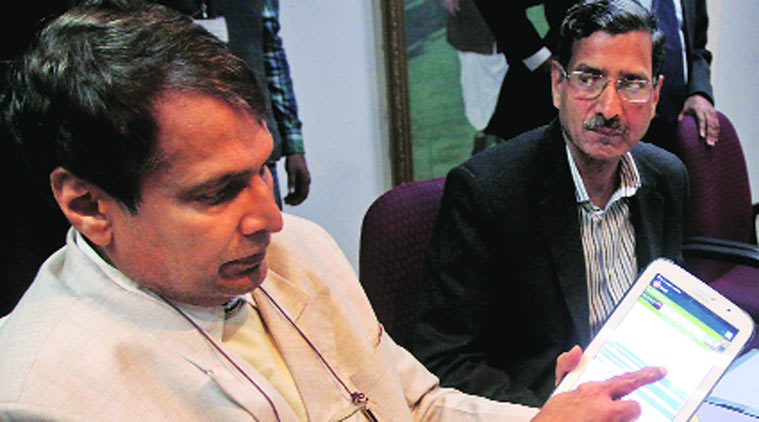 Suresh Prabhu launches an app for registering complaints. (Source: Express photo by Prem Nath Pandey)
Suresh Prabhu launches an app for registering complaints. (Source: Express photo by Prem Nath Pandey)
PROMISES
In the vision it outlined through the rail budget, the Ministry of Railways in 2014 adopted a near-plan holiday citing a vast number of pending projects. Money was allocated to 30 ongoing projects with high rates of return. Foreign direct investment was to arrive in a big way. A never-before 40 per cent higher allocation was given for cleanliness of trains and stations. That apart, Narendra Modi himself outlined specific works for speedy implementation. In a year that has seen a change of ministers with Suresh Prabhu replacing D V Sadananda Gowda in November, progress on various fronts has been slow as Railways took a course revision while Prabhu settled down.
Pluses
In January, the government ended a two-year paralysis in high-level appointments, installing new Railway Board members and general managers. A few steps, some of these already in the works, have also been taken in improving passenger amenities, such as introducing e-catering, mobile apps for ticketing as well as women’s safety, complaints registration and WiFi in a few stations. Decisions taken to install CCTV in coaches and procure modern, electric train sets from global makers; efforts on to increase freight business 15 per cent this year, though the shortage of wagons remains.
MINUSES
The speed of existing trains is yet to increase, punctuality figures have fallen drastically, and cleanliness and on-board services remain as they were. Not a rupee of foreign direct investment has arrived as was intended, despite a policy being in place. Work on introducing bullet trains has been slow, as has the progress of one of the PM’s favourite projects, that of four railway universities. Part of the slowdown is believed to be because the centrepiece of Prabhu’s turnaround plan, enhancing the network’s capacity through borrowed money, is expected to start getting results only after three years or more. Here, the railways have so far been unable to come up with a list of bankable projects that LIC would like to fund, despite an MoU in place for Rs 1.5 lakh crore in five years. Prabhu handed much of his powers to his minister of state Manoj Sinha recently, having earlier delegated the powers to decide on commercial tenders. Of the number of committees with experts from outside as well as inside the railway system formed, some have submitted their reports, but all that is yet to translate into action.
Self-rating
“To pull Railways out of the present situation, we are working on immediate, short-term, medium-term and long-term strategies. We are addressing customer-centric issues immediately. For decongestion, improving safety and capacity augmentation, we have formulated a suitable strategy. Any project involving doubling, tripling of line which gives the relief in the fastest way will require a minimum three years of completion and a mid-term strategy accordingly has been worked out. Our objective is to make railways a profitable, efficient, customer friendly and safer mode of transportation.”
♦ Suresh Prabhu
Railways Minister
Opposition rating
“They promised bullet trains, promised to fast-track ongoing projects and promised big-ticket projects. I don’t think anything has taken off at the ground. Many projects like doubling work, new lines started during the UPA government have come to a standstill because of lack of funds. Many World Bank-assisted projects are making slow progress.”
♦ Mallikarjun Kharge
head, Cong shadow group on railways
Home: Film ban, NGO watch and unfulfilled LWE promise
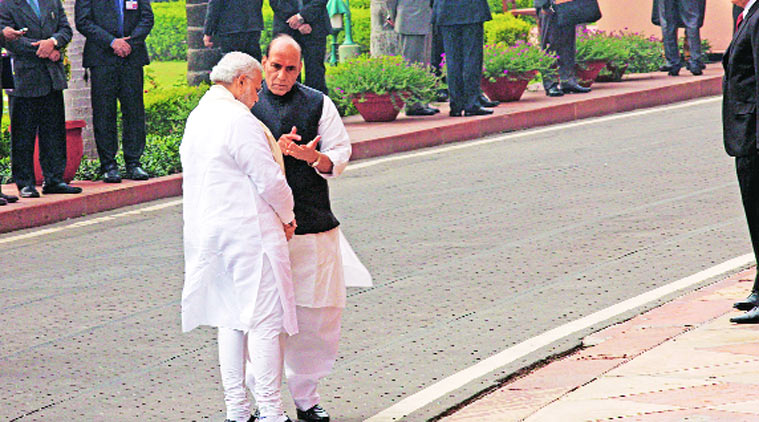 PM and Rajnath Singh in discussion in Parliament. (Source: Express photo by Neeraj Priyadarshi)
PM and Rajnath Singh in discussion in Parliament. (Source: Express photo by Neeraj Priyadarshi)
Promises
Soon after taking charge, Home Minister Rajnath Singh promised a new national policy to address Left Wing Extremism, as well as long-term visas to persecuted minorities from Pakistan, Bangladesh and Afghanistan.
Pluses
Among administrative measures, enhancement of compensation to civilian victims of communal, terrorist or Naxal violence from Rs 3 lakh to Rs 5 lakh, and for 1984 anti-Sikh riot victims also to Rs 5 lakh. The ministry cleared recruitment of 33 per cent women in police forces in all UTs and Delhi; higher financial powers to DGPs of Central Armed Police Forces (CAPF) for various procurements. Merger of Persons of Indian Origin (PIO) and Overseas Citizens of India (OCI) cards simplifies system to one OCI card with enhanced benefits; electronic-tourist visas extended to 150 countries. In policing, NIA unearthed a module of Jamaat-ul-Mujahideen Bangladesh; arrested more than 60 cadres of Assam’s NDFB(S) that had killed gunned down 78 people in 2014. Incidents of LWE-related violence dipped 22 per cent from the previous year.
Minuses
The ministry has courted a number of controversies, including a ban on India’s Daughter, Leslee Udwin’s documentary on the 2012 gangrape on a bus in Delhi. A lookout circular against Greenpeace activist Priya Pillai led to the Delhi High Court pulling the government up. The government also put donations from 16 overseas NGOs including Ford Foundation subject to prior approval. A major controversy was the ministry’s removal of home secretary Anil Goswami amid allegations that he had called CBI officials to stall the arrest of Matang Sinh in the Saradha scam. The promised LWE policy remains on the drawing board. Bihar, Himachal Pradesh, Punjab and Telangana are without governors. The annual chief ministers’ conference on internal security is yet to be organised. The government is yet to fulfil its promise of bringing underworld don Dawood Ibrahim to India for trial. Nor has it released, as promised, the religion census for 2011.
Self-rating
“The security situation in J&K, northeastern states and LWE-affected states has shown overall improvement with the security forces able to contain militant and terrorist activities. The cabinet approved enhanced relief of Rs 5 lakh to the next of kin of each deceased person in the 1984 anti-Sikh riots.”
♦ Rajnath Singh
Home Minister
Opposition rating
“Communal tension and social disharmony has increased in the last year. That speaks for itself. There is a perceived feeling of too much power being concentrated in the hands of the Centre and that shows in the appointment and removal of governors and their interference on the working of elected governments. They always talk about strengthening the states but all their actions have been in the opposite direction.”
♦ Ashwani Kumar
Member, Cong shadow group on Home
Minority Affairs: USTAD skills and Najma’s ‘grading’ of minorities
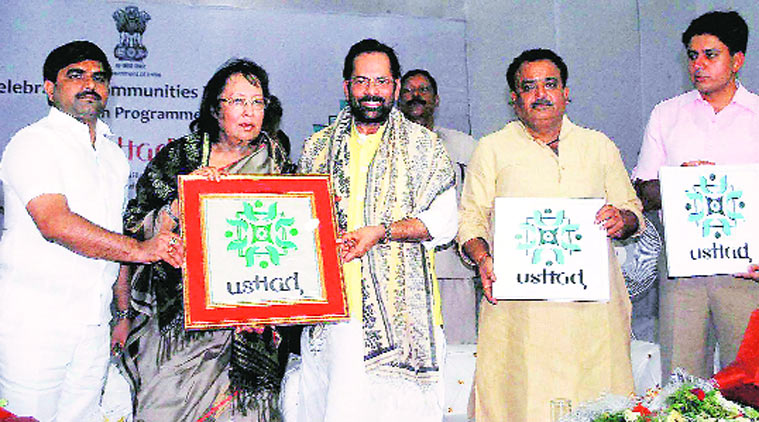 Najma Heptulla and MoS Mukhtar Abbas Naqvi at USTAD launch. (Source: PTI photo)
Najma Heptulla and MoS Mukhtar Abbas Naqvi at USTAD launch. (Source: PTI photo)
PROMISES
In one of the first announcements for minorities by the new government, Finance Minister Arun Jaitley’s first budget announced the government will move for “Upgradation of Traditional Skills in Arts, Resources and Goods”.
PLUSES
The ministry has moved the direct benefit transfer (DBT) way for disbursement of its scholarship schemes to do away with middlemen. The system of applications is being made digital. The traditional skills upgrade project, now called USTAD, was launched last week in Varanasi. The Maulana Azad National Academy for Skills was set up. Digitisation of Wakf properties is under way.
MINUSES
Only one proposal from the ministry — for a hike in the authorised share capital of the National Minorities Development and Finance Corporation — taken up by cabinet. Minister Najma Heptulla’s many controversies have included making a comparative assessment of the “minorityness” of Parsis vis a vis Muslims and, more, recently stirring a hornet’s nest on the RSS line of “all Indians are Hindu”. She has since denied endorsing that line and said she had used the word Hindi.
SELF-RATING
“We have just launched USTAD, we have high hopes on it. Besides all the flagship projects of this government like the Jan Dhan Yojana and the universal insurance plan are targeted at the poor and according to the Sachar committee report minorities are socio-economically backward… We are looking at launching the Nayi Manzil programme for integration of madrasa students this year. Work on developing Wakf land for the welfare of the community is also on.”
♦ Najma Heptulla
Minority Affairs Minister
OPPOSITION RATING
“Except for one programme, all the schemes of the ministry were actually started by UPA. Even these programmes have taken a backseat, including strengthening of the Wakf Act and institutions which was a manifesto commitment of the NDA. No steps have been taken to implement the amended provisions of the Act. ”
♦ K Rehman Khan
Former minority affairs minister
Environment & Forests: Air quality index takes off, amended green laws wait
 Prakash Javadekar during a visit to dumping grounds outside Mumbai. (Source: Express photo by Deepak Joshi)
Prakash Javadekar during a visit to dumping grounds outside Mumbai. (Source: Express photo by Deepak Joshi)
Promises
During his Independence Day speech, the Prime Minister talked about a “zero defect, zero effect” manufacturing thrust, the second part clearly referring to the effect of industries on environment. The government promised to ensure stricter compliance to environment laws, while making the appraisal and regulation process transparent, time-bound and predictable. It promised to update laws, introduce stricter pollution standards, and ensure faster clearance to industrial and infrastructure projects.
Pluses
The ministry has launched an air pollution index, formed a committee to review six laws, and announced stricter pollution norms for the cement industry. Recently, the cabinet cleared a law to set up an authority to manage thousands of crores of accumulated compensatory afforestation funds lying unused for over a decade. Defence infrastructure along the Chinese border, road connectivity in Naxal-affected areas, electricity transmission lines have been put on an automatic approval route. A classification of industrial sectors based on their pollution potential is in the works.
Minuses
The government promised amendments to environment laws in the budget session but is far from finalising these. Stricter pollution norms have so far come only for the cement industry, while a draft notification for introducing some new norms for thermal power plants have just been released for public consultation. Forests yet to be classified into “violate” and “inviolate” zones.
Self-rating
“From image makeover to ushering in transparency, cutting red tape to strengthening regulatory and conservation mechanism, there had been a lot of achievements during the last one year. We could transform the perceived image of the ministry from a roadblocks, bottlenecks and speed-breaks ministry to a transparent, people-oriented ministry… I accorded top priority to achieve policy-based decision making; decentralisation of decision making; and strengthening of conservation and regulatory mechanism. Big achievements include approval of all defence and other projects of strategic importance pending for years together; mandating 3,206 industrial units in 17 critically polluting sectors to install 24×7 monitoring equipment; launching of National Air Quality Index to educate the masses to help control pollution;CAMPA Bill to provide $6bn to the states for afforestation… The courts have been intervening in a number of cases due to infirmity in laws, non-clarity in rules and non-transparency in processes. We appointed a high-level committee to scrutinise existing laws since many decisions were being challenges in the courts. Wider consultation with all stakeholders is near completion, a comprehensive EP Act is on the anvil for more green growth.
♦Prakash Javadekar
Environment & ForesTS Minister
Opposition rating
“The first year saw systematic efforts to dilute the Forest Conservation Act, the Environment Protection Act and the Forest Rights Act. They have got the T S R Subramaniam Committee report which is a blueprint for environmental disaster. They are hell-bent on going ahead in the name of improving or increasing the ease of doing business. They are now systematically dismantling the edifice of environmental regulation that has been built up over the last 30 years. So, I am afraid, on environment, the performance record of this government is very very dismal.
♦ Jairam Ramesh
Member, Cong shadow group on MoEF
External Affairs- Engagement with leaders, visibility
Promises
The government signalled its intent to about engage with SAARC countries when Narendra Modi invited all SAARC leaders to his swearing-in. It engaged with major powers, including the US and China, and got major countries and companies to announce investments in India.
Pluses
The government took a leadership role in SAARC, and showed it during the Nepal earthquake. It broke the deadlock on the Indo-US nuclear deal. The foreign secretary’s SAARC Yatra gave a reason to connect with Pakistan, after foreign secretary-level talks has been cancelled. The Land Boundary Agreement with Bangladesh has been passed. The process for purchasing Rafale jets, which was locked in negotiations, was restarted. The government showcased Make in India across the world. It convinced China to open the alternate route of the Mansarovar Yatra through Nathu La, got the international community at G-20 to act against black money, and evacuated Indians from Yemen, Nepal, Iraq, Ukraine and Libya.
Minuses
The policy towards Pakistan remains unclear. Although the knot on nuclear liability has untied, private companies are yet to come on board fully. The PM’s attempt to get the Chinese leadership to commit to clarification on the Line of Actual Control has not yielded that result.
Self-rating
“It’s been an interesting year for MEA. The increased emphasis on our immediate neighbourhood was long overdue. Most importantly, I think the one message that has gone out to our own people is that Indian lives, wherever they may be, are of paramount importance. I also like to believe our missions and embassies across the globe are far more accessible to our own people than what they were before. We live in a changing world where the challenges are endless. MEA is the face of this new India for the rest of the world. We have excellent people fully committed to looking after our interests in every corner of the world. The message to all Indians should be loud and clear – we are always there to look after their interests. The foreign policy has been tweaked to further the interests of India.”
* V K Singh, MoS, external affairs
Opposition rating
“No other Prime Minister has travelled so much. And what is the net result? Nil. Whichever countries he has visited, they have become more hostile. He wanted to cultivate Pakistan; what is the result? He visited the US and Barack Obama visited India, but no goodwill was created. Remember what Obama said before he left the Indian soil. Similarly, no substantial investment has come from the US. The Chinese President visited India, after which Beijing committed billions and billions of dollars to Pakistan. Ultimately if you look at all his 17 or 18 foreign visits and his government’s engagement… it has only worsened with some countries. Afghanistan has been a friend; China has already snatched it away. His personal prestige may have been enhanced, but the government’s conduct of foreign policy has not enhanced the nation’s prestige.”
* M Veerappa Moily, head, Congress shadow group on External Affairs
Law & justice- New way to appoint top judges, end of many laws
 Gowda in Parliament.
Gowda in Parliament.
Promises
Legal reforms, especially for replacing the collegium system of appointments to the higher judiciary with a more transparent system, were a priority. The government has an ambitious plan to abolish one outdated law per day, and to introduce a new litigation policy to prevent intra-government litigation. Law has had two ministers in the first year, Ravi Shankar Prasad followed by D V Sadananda Gowda.
Pluses
The National Judicial Appointments Commission Bill along with the mandatory Constitution Amendment Bill was passed, replacing the collegium system. The NJAC comprising the Chief Justice of India, his two most senior brother judges in the Supreme Court, two eminent jurists (to be selected by a committee headed by the PM) and the law minister is responsible for appointments and transfers in the higher judiciary. The constitutionality of the NJAC is pending before a five-judge bench in the Supreme Court; the government has told the court that there is no way the collegium system can be revived.
National Litigation Policy prepared to prevent litigation among government departments. After receiving reports from the Law Commission and a committee of experts, Gowda has tabled four Bills to repeal outdated laws. Another Bill, aimed at regulating and speeding up commercial arbitration, is ready for the next session of Parliament.
Minuses
Many legal experts say the NJAC could be part of the government’s plan to have a pliant judiciary. While in opposition, the BJP had promised to involve the common man in pre-legislative processes but it has not yet happened.
Self-rating
“In just six months, I have tabled four bills. The first one was aimed at repealing 35 outdated laws, the second one 90 Acts, the third one repealed 758 Acts and the fourth Bill repeals 187 Act — a total of 1,070. This could be a Guinness world record. For ease of doing business, we have decided to make the arbitration process stronger and time-bound. The bill in this regard is ready and it is awaiting cabinet approval… Since there are so many disputes of commercial nature pending in various high courts for a very long time, we have tabled the Commercial Divisions in High Courts Bill. It may be cleared in the next session. We have prepared a National Litigation Policy… While we have received widespread applause for enacting (NJAC), the matter is sub judice; I will not say anything.
* D V Sadananda Gowda, law minister
Opposition rating
The BJP promised justice for all… There is nothing in what they have done so far for the aam aadmi… On the NJAC Act, how can the government come up with such a law? To put a clause that two members can veto any name is sure indicator of the Modi government’s mala fide intentions.
* Kapil Sibal, former law minister
Defence- Rafale jets done, one rank, one pension ‘soon’
 Minister Manohar Parrikar at floating out ceremony for Scorpène submarine.
Minister Manohar Parrikar at floating out ceremony for Scorpène submarine.
Promises
In line with the “Make in India” slogan, the ministry has said it will amend the defence procurement policy (DPP) to boost a domestic defence industry. Minister Manohar Parrikar has said the blacklisting policy and role of representatives in defence acquisitions will be reviewed. The BJP came to power on the promise of better handling of cross-border problems and one rank one pension. During the year, Border Roads Organisation has been brought under the ministry.
Pluses
The acquisition of 36 Rafale fighter jet, pending for over three years, has been a major decision. The ministry has played key roles in rescue and relief operations during the Kashmir floods and the evacuation of Indians from Yemen. The government has prepared a budget has been set for one rank, one pension; it promises to announce the scheme soon.
Minuses
The April-May deadline for a revised procurement policy is set to end. Though the ministry has cleared artillery acquisition, aircraft purchases and submarine programmes, no contract has been signed yet. The Rafale deal comes at the expense of negotiations that were going on with the manufacturer, with the Centre approaching the French government. One rank, one pension is not yet in; nor are promised war memorials for the forces. The budget for the mountain strike corps has been curtailed. The DRDO has been headless for four months.
Self-rating
“Decision making process suffered under UPA II. That has been accelerated under this government. In that sense, we are trying to reverse the policies of UPA II. Money is a challenge but then we are tweaking policies… Defence procurement policy will come through shortly… One rank, one pension is ready, an announcement is likely any moment.”
* Rao Inderjit Singh, MoS, Defence
Opposition rating
“No one knows what the status of preparedness of the Indian Army is. Recently there were reports that the Army’s ammunition won’t even last only 10 days in the event of a war. Similarly, we do not know the status of the procurement policy or Make in India as far as defence is concerned. On the purchase of Rafale fighter plans, there is confusion and a state of disquiet.
* Ashwani Kumar, member, Congress shadow group on defence.
Parliamentary Affairs- Ordinances, Acts and a Rajya Sabha challenge
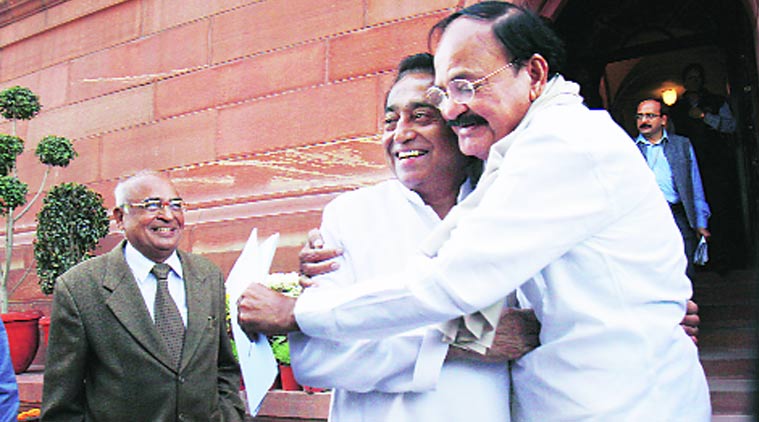 Venkaiah Naidu with the Congress’s Kamal Nath in Parliament.
Venkaiah Naidu with the Congress’s Kamal Nath in Parliament.
Promises
The government had undertaken to bring in financial reforms and a changed version of the Land Acquisition Act. Pending the passage of relevant bills, it had brought them into effect through ordinances.
Pluses
Of six ordinances, five were converted in to Acts. They include The Insurance Laws (Amendment) Bill, 2015, The Coal Mines (Special Provision) Bill, 2015 and The Mines and Minerals (Development and Regulation) Amendment Bill. A total 47 bills were passed.
Minuses
Two important bills, The Right to Fair Compensation and Transparency in Land Acquisition, Rehabilitation and Resettlement (Second Amendment) Bill 2015 and The Constitution (122nd Amendment) (GST) Bill 2014, are currently struck. The first bill has been referred to a joint parliamentary committee and the second to a Rajya Sabha select committee, primarily because the government has not been able to mobilise adequate support in the RS.
Self-rating
“Both Houses of Parliament registered a record performance in terms of the number of sittings and transaction of legislative business. We passed 47 Bills, the maximum during the last six years. The constitution amendment relating to the operationalisation of the Land Boundary Agreement with Bangladesh was unanimously passed by Parliament. The Black Money Bill was also passed. If calculated from May 2014, the Lok Sabha held 90 sittings, the Rajya Sabha 87, the highest in the last 10 years. The Government is keen on holding 100 sittings a year as recommended by the last conference of chief whips and floor leaders of legislatures in October.”
* M Venkaiah Naidu, parliamentary affairs minister
Opposition rating
“Venkaiah Naidu and his deputies, Mukhtar Abbas Naqvi and Rajiv Pratap Rudy, are doing a good job while pursuing the government agenda… Naidu is particularly very hardworking. If they are facing difficulties in the Rajya Sabha, it is only because the numbers are stacked against them. They would do well by reaching out to leaders of all parties before they come to the Rajya Sabha with any controversial business.”
* Rajeev Shukla, former MoS, parliamentary affairs
Tourism, Culture- E-visas, Lalit Kala Akademi administrator
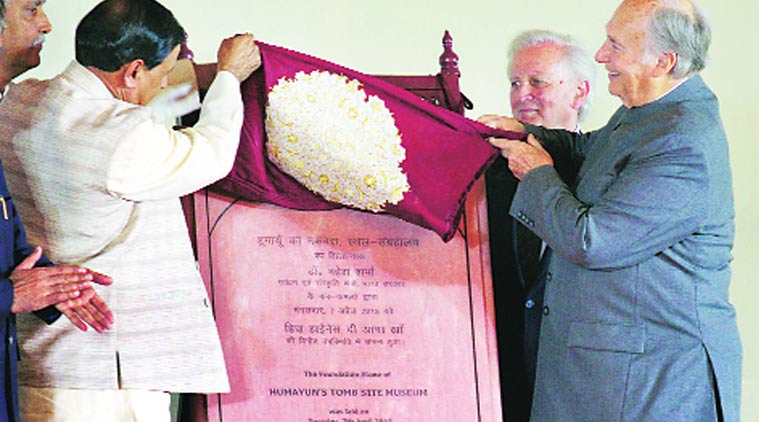 Mahesh Sharma at site of proposed museum near Humayun’s tomb.
Mahesh Sharma at site of proposed museum near Humayun’s tomb.
Promises
In tourism, to make India safer for foreign visitors especially women), liberalise visa, add new circuits, add heritage sites under better conservation plan. In culture, to fill top-level vacancies in premier organisations. In November, Dr Mahesh Sharma replaced Shripad Naik as minister in charge of both tourism and culture. The year saw the government taking control of Lalit Kala Akademi by appointing an administrator.
Pluses
India’s ranking in WEF Travel & Tourism Competitiveness Index jumped to 52 in 2015 from 65 in 2013, though it may not have been the result of just one year’s work. E-tourist visas or visas on arrival to 77 countries including China. Religious and spiritual circuits worked out or being firmed up. Incredible India helpline for tourists.
In culture, process started for filling up vacancies and making regular appointments at institutions such as National Archives. Twenty five ASI-protected heritage sites launched as “Adarsh Smarak” with improved visitor amenities. Museum reforms with digitisation of collections, “Project Mausam” for cooperation with Indian Ocean nations and revival of historical ties.
Minuses
Government could not utilise funds for its large schemes; Rs 500 crore for Swadesh Darshan was later cut to Rs 20 crore, Rs 100 crore for national pilgrimage mission to Rs 15.6 crore (this budget, the allocations are up again, to Rs 600 crore and Rs 100 crore). Crime incidents involving women tourists in various states. In culture, frequent criticism that government policies are guided by a right-wing ideology.
Self-rating
“We have increased the list of countries for e-visas and launched helplines to make tourism safe. We have embarked on strategic disinvestment of loss-making hotels. Through Swachch Bharat, we are also aiming to infuse cleanliness in all tourism centres. Our focus is also to bring up so far unchartered areas like circuits in the Northeast to the country’s tourism map. In culture, our efforts are to highlight India’s rich heritage to the world as well as to the young generation in the country. We have brought in transparency in appointments.”
* Mahesh Sharma, Tourism and Culture Minister
Opposition rating
“We have not seen any new initiative. They are talking about e-visas. That was started by us… See what they have done to Lalit Kala Akademi. They have taken it over. They have changed the director general of National Museum overnight… The only agenda of this government is saffronisation.
* Kumari Selja, former tourism and culture minister
Urban development- Centerpiece Swachch Bharat
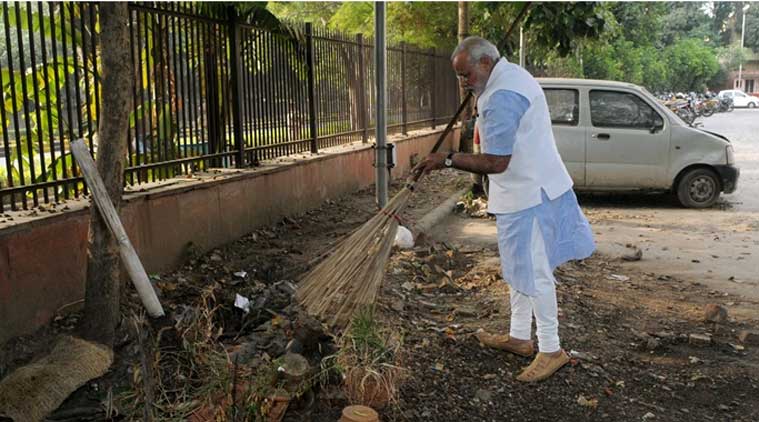 Narendra Modi
Narendra Modi
Promises
100 smart cities, Housing for All by 2022, and Swachch Bharat mission.
Pluses
Swachch Bharat, which kicked off last year, received around Rs 859 crore last year and Rs 1,000 crore this year. The scheme aims at building 1.04 crore toilets in individual households and 5.08 lakh public toilets. Ahmedabad Metro project sanctioned during the year.
Minuses
Housing for All yet to take off; names for 100 smart cities not yet finalised.
Self-rating
“Centre is committed to spending about Rs lakh crore during the next five to six years as against only Rs 36,000 crore during nine years of JNNURM. Political leadership at all levels has been sensitised to urban challenges. States are being given the much-needed freedom in design and implementation of urban initiatives to achieve intended targets. A new beginning is being made in the crucial urban sector since management of urbanisation is the most formidable challenge for India during this century.”
* M Venkaiah Naidu, Urban Development Minister
Opposition rating
“The worst thing they have done is that they have amended the Real Estate Regulatory Bill which we introduced in 2013. It was intended to be pro-buyer and protect the interests of buyers. They have converted it into pro-builder. They have destroyed the confidence of home buyers. There are no new initiatives or new measures; there is talk of only smart cities but there is no concrete or real plan to achieve that. They have not done anything beyond rhetoric.
* Ajay Maken, former Urban Development Minister
Apr 16: Latest News
- 01
- 02
- 03
- 04
- 05











